Have you ever been frustrated because your computer keyboard doesn’t have the symbol you want? Maybe it’s something as simple as the ¢ sign or something more exotic like the section symbol §. The good news is that your keyboard can make these special characters and many more. In this tutorial, I’ll show how to make symbols with your keyboard. It’s easier than you think.
Knowledge You’ll Gain
- Master Alt Codes: Learn how to use Alt codes to type symbols like €, °, §, and more, directly from your keyboard.
- Navigate the Windows Character Map: Discover this powerful tool for inserting a wide range of symbols.
- Unlock Hidden Keyboard Shortcuts: Find out about built-in shortcuts for common symbols.
- Customize Your Symbols: Learn how to create your own shortcuts for frequently used symbols.
- Troubleshoot Symbol Issues: Understand why some methods might not always work and discover solutions for common problems.
Before I get to the instructions, you should know there are many ways to make these. There can be multiple codes for the same item. Your choices will depend on where you need the code, such as a Microsoft Word document, email, web page, and more.
And to clarify, when I say “keyboard symbols,” I mean I’m using the keyboard to make them. This is a bit different than representing symbols on a keyboard using your Shift key. For example, this isn’t about typing Shift + 2 to produce the “at sign” – @.
While these codes are universal, they don’t work across all applications or even with your regular keyboard. That is why it helps to know multiple solutions.
What is a Special Character?
This depends on the context and vendor. For example, sometimes, when you create an online password, you’ll see a hint or tooltip that references non-numeric keys like @, #, $, %, &, *, and +. These are easy to enter as they are on your keyboard. These are “special characters” examples, even though they exist on your keyboard.
Special typographical symbols are a type of character that does not exist on the standard keyboard. These special characters range from currency symbols to legal symbols to mathematical symbols to diacritics. These are the tiny glyphs you see over letters such as a grave – è.
In contrast, there are a lot of symbols that require you to enter or type multiple keys. There are no dedicated keyboard keys for them. However, even symbols that are on your keyboard can also be entered using these methods.
If you use one of Microsoft’s Office programs to insert a symbol, they have a dedicated tab called Special Characters with the assigned shortcut key. These special characters relate to formatting, punctuation, em dashes, copyright ©, and trademark ™ signs.
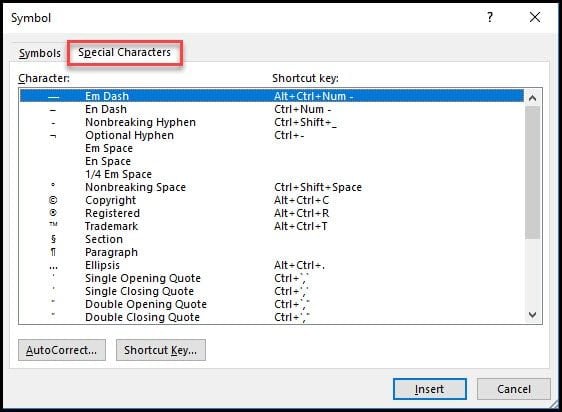
A more common set of special characters are for things like accented letters, fractions, and currency symbols.
For this article, I’m going to call all these items “symbols.” This may upset some purists, but I don’t want to get into code page history except to say some of these codes came about before we had graphical interfaces.
Symbol Representations & Codes
Depending on your symbol, there could be several codes that represent it. For example, every key on your keyboard has a code that represents the same value. So while the keyboard accounts for over a hundred entries, there are thousands of symbol codes when you factor in different languages.
Alt Codes
Alt codes come from pressing and holding down your Alt key and pressing a specific set of numbers. It could be from 1 to 4 digits. These codes are useful when you don’t have some symbol tool like a character map. They can also be faster if you know the codes.
There are 256 Alt Codes in the first set. The first 126 map well to a US English keyboard and work in almost any application. The remaining items are called “extended ASCII” and work fairly well in all applications.
I said “fairly well” because the beginning numbers 0 to 31 represent other graphical symbols. For example, pressing ALT + 1 will get you a smiley face ☺, while ALT + 3 will get you a heart ♥. And depending on where you use the code, the colors may change, such as a red heart.
However, there are Alt codes with numbers greater than 255, which can pose problems in certain programs. In particular, programs outside Microsoft Office.
Things to Remember About Alt Codes
- You must use the numbers on the Numeric keypad. Using the number keys below your function keys won’t work.
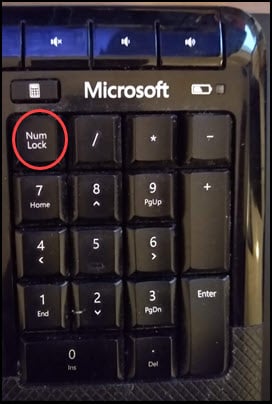
- Num Lock should be on.
- If your keyboard doesn’t have a dedicated Numpad, you may have to use a Fn key combined with a Num Lock key.
- Not all code symbols show on printouts even though they show on your screen.
- Apple has its own method and doesn’t rely on these codes.
On a Mac, you’ll need to use the Character Viewer instead of using Alt codes. Apple has a support document on this.
How to Find Alt Codes
The problem with finding ALT codes is not all lists are complete. Some have the first 128 items. Others include extended ASCII, and a few have all of them, including the 4-digit Alt Codes that start with 0.
One site that I prefer is Alt-Codes.net. It has a numeric listing that is larger than most. While it doesn’t provide the literal name of the symbol like “copyright,” it’s easy to find the graphical representation. It also provides some groupings on the sidebar and top navigation like “currency,” “language,” “gender,” and others. It also has a test window where you can try out the symbol code.

TextExpander: Worth It? Find Out.
Is TextExpander the right tool to boost your productivity? Get an independent assessment, weigh the pros and cons, and make an informed decision. Find out why I’m a fan.
Read the ReviewHow to Create Symbols Using Alt Codes
Going back to my story, here are three examples of codes.
Example 1: The Cents symbol (¢)
- Open a document where you want to see the symbol.
- Make sure the Num Lock key is on.
- Press and hold down your left Alt key.
- Press the 1 key on your Number pad.
- Press the 5 key on your Number pad.
- Press the 5 key on your Number pad.
I mentioned the left Alt key because some keyboard language settings don’t allow the right side key to work.
Example 2: The Degrees symbol (°)
- Open a document where you want to see the symbol.
- Make sure the Num Lock key is on.
- Press and hold down your left Alt key.
- Press the 0 key on your Number pad.
- Press the 1 key on your Number pad.
- Press the 7 key on your Number pad.
- Press the 6 key on your Number pad.
Notice how in this example, you have to type the 0. If you don’t, you’ll get a different symbol.
Example 3: The Section symbol (§)
- Open a document where you want to see the symbol.
- Make sure the Num Lock key is on.
- Press and hold down your left Alt key.
- Press the 2 key on your Number pad.
- Press the 1 key on your Number pad.
You can also use these code combinations when your keyboard doesn’t work properly. For example, a reader contacted me about his @ key not working. Something about a cat sitting on the keyboard. The workaround is to press ALT + 6 + 4 to get @.
Currency Symbol Examples
Here are some examples you can try. You might notice that lower numbers have a dedicated keyboard key, such as the $ sign.
| Currency Symbol | Alt Key Codes |
|---|---|
| $ (Dollar) | Alt 3 6 |
| ¢ (Cents) | Alt 1 5 5 |
| £ (Pound) | Alt 1 5 6 |
| ¥ (Yen) | Alt 1 5 7 |
| ƒ (Guilder) | Alt 1 5 9 |
| € (Euro) | Alt 0 1 2 8 |
| ₣ (French Franc) | Alt 8 3 5 5 |
The last example for the Euro € sign has a 4-digit Alt code, and you must put in the leading 0. Even though this code has 4 digits, it is still less than 256, so it works in just about any application, including Gmail.
Trademark, Copyright & Fraction Symbols
| Symbol | Alt Key Codes |
|---|---|
| ™ (Trademark) | Alt 0 1 5 3 |
| © (Copyright) | Alt 0 1 6 9 |
| ® (Registered Copyright) | Alt 0 1 7 4 |
| ℅ (c/o) | Alt 8 4 5 3 |
| № (Numero sign) | Alt 8 4 7 0 |
| § (Section sign) | Alt 2 1 |
| ½ (One half) | Alt 1 7 1 |
| ⅓ (One third) | Alt 8 5 3 1 |
| ¼ (One quarter) | Alt 0 1 8 8 |
| ⅛ (One eighth) | Alt 8 5 3 9 |
Alt Code Outlier Symbols – 0 to 31
Other symbols for low-range codes were displayed in my Gmail and Microsoft Word testing. However, I would get different characters in these apps. Here are some popular examples that may be easier than using Unicodes. After 31, the codes synced.
For example, typing Alt 3 in Gmail produced a heart symbol ♥. However, once the email was received, the heart turned red. The same thing happened for the smiley – ALT 1. ☺
Below are some examples I use in documentation.
| Symbol | Alt Code Keys |
|---|---|
| White circle ○ | Alt 9 |
| Right pointer ► | Alt 1 6 |
| Left pointer ◄ | Alt 1 7 |
| Up arrow ↑ | Alt 2 4 |
| Down arrow ↓ | Alt 25 |
| Left arrow ← | Alt 27 |
| right arrow → | Alt 26 |
| Down triangle ▼ | Alt 3 1 |
Why Alt Codes Don’t Always Work
Sometimes, the Alt codes don’t work as expected. This has to do with details like rich editors, Widows registry settings and code pages. Code pages are like a translation table and can be applied by a software program or operating system. It’s purpose is to make sure symbols are mapped correctly. There is a precedence system and an application code page will be used instead of the operating system.
For example, if you tried to enter the Alt code for the French Franc in Microsoft Word, WordPad, or Microsoft Outlook it would work fine. But it doesn’t work in Gmail, Microsoft Excel, my code editor, or other programs. With these programs, any code greater than 255 will provide unexpected results. You’ll see a symbol produced, but it won’t be what you want, making it more confusing.
Unicodes and Languages
Unicodes are another way to represent and standardize characters. A big difference is set size as there are well over 100,000 Unicodes. Unicodes also represent many more languages. While there are symbols in the set, you won’t find things like trademarked symbols. For example, there isn’t a Unicode for the Windows symbol. ![]()
How to Enter Unicodes
The Unicodes work in a different way. You do not need to use the numeric keypad; the letters are not case-sensitive.
Below are the steps to create the ¢ sign.
- Open a document where you want to see the symbol.
- Press 0 0 a 2.
- Press and hold Alt
- Press X.
- Let up on the keys.
Again, some programs don’t work with unicodes. However, with the advent of “AI tools”, some programs allow you to type your request. For example, I used the “Help me write” feature in Google Docs to insert the French Franc sign.
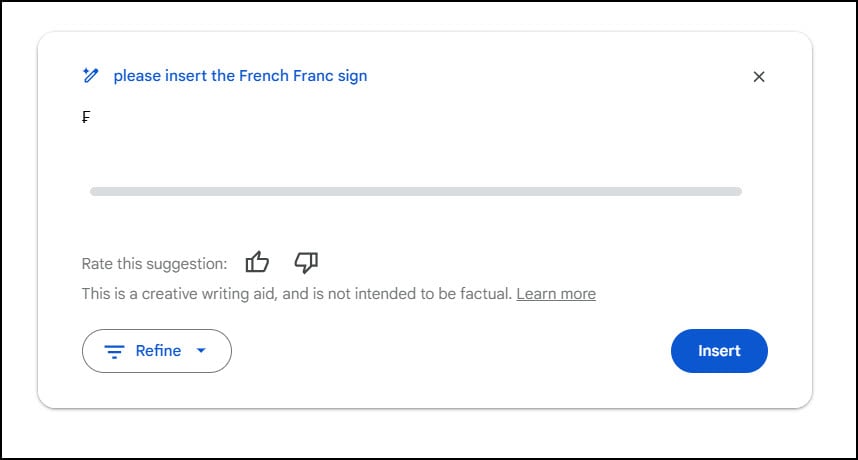
Surprisingly, the same solution doesn’t work in Gmail. In this case you’re better off going to a service like https://symbl.cc and searching for your item. You can then highlight and copy the symbol and paste it into your message. From there, you can resize and change text colors.
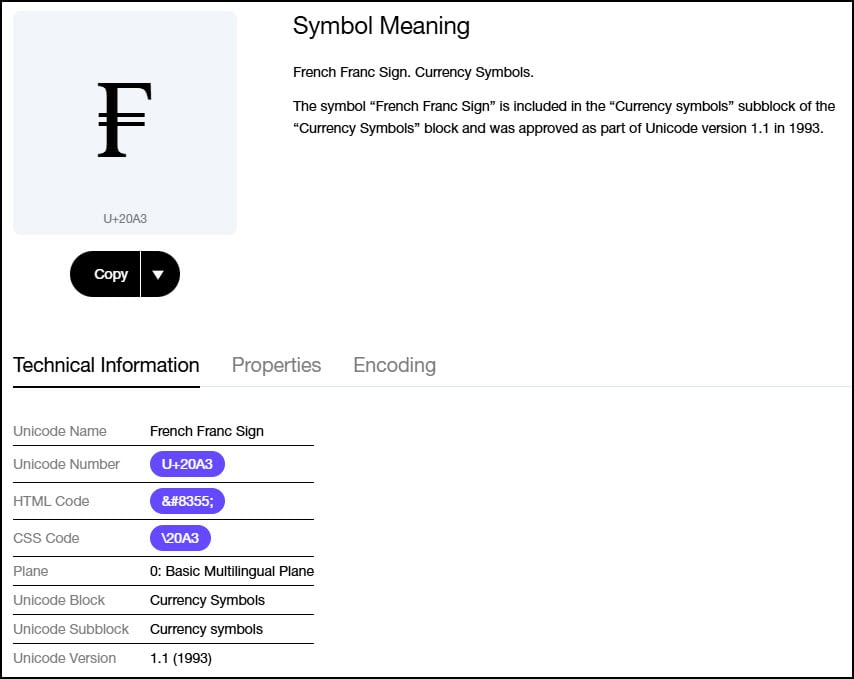
Entering Unicodes in Microsoft Excel
I found entering some of these codes in Excel a challenge. Although the documentation says it accepts Unicodes, I couldn’t do it using those codes. I had to use HTML codes or HTML-Entity Decimal codes. This name differs based on which lookup service I used.
To give an example, I wasn’t able to use the Unicode for a checkmark. I had to use a different code.
- Find the HTML code for your symbol.
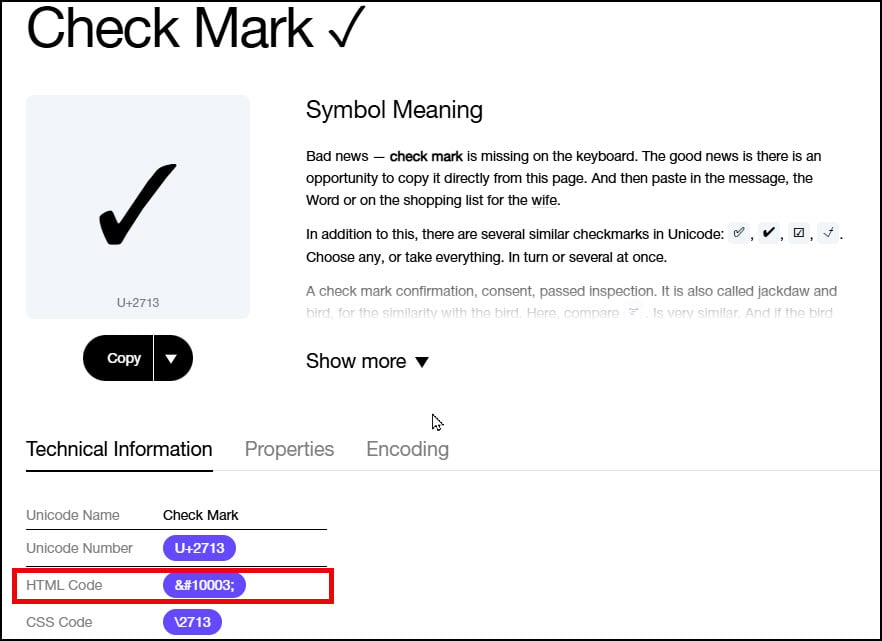
- Look for the value in the HTML-code field.
- Copy just the number. No punctuation.
- In Excel, type =UNICHAR(10003). The number in ( ) represents your HTML code.
- Press Enter.
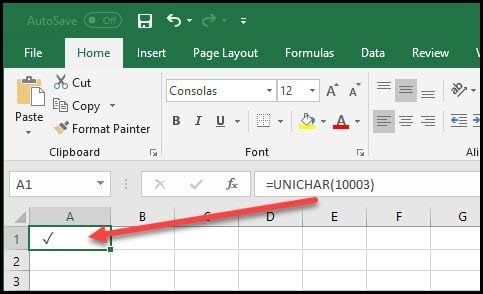
How to Make Symbols with Laptop Keyboard
Creating symbols with a laptop can be more cumbersome. The keyboard layout for most laptops has fewer keys. Very few have a dedicated numeric keypad.
Trying to find the Num Lock key on notebooks can be challenging. To give an example, my Asus notebook doesn’t have a dedicated key. I had to search Google to find out where it was.
Next, I had to run a program called OSK that brought up an on-screen virtual keyboard. Then I had to hit an Options button to toggle Turn on the numeric keypad.
Other systems may have visual keyboards under some accessibility options.
TextExpander
Another option is to use a software program such as TextExpander. (Please note I am an affiliate for this program.) The program works with Microsoft Windows, Mac OS, and iPad and saves your text shortcuts to the cloud. For example, I can assign a keyboard shortcut of “zc” and have it equate to the Alt codes I would use for the cents sign.

The program has many predefined symbols, which may save you from finding the initial key codes. Moreover, the program does a lot more than special symbols. It can string together entire documents.
Use an Insert Symbol Tool
The methods mentioned above were direct, and you had to know the symbol code. However, an easier method is to check your program for a menu option that allows you to insert symbols.
Many products include this option. For example, Microsoft Word, Microsoft Outlook, Microsoft Excel, and Microsoft PowerPoint all have an Insert menu with an option for Symbol. The most common symbols are included.
The nice thing about this symbol utility is you don’t need to figure out which code set to use. Simply highlight the symbol, click the Insert button, and close the utility. However, you could change the code set by choosing another option from the drop-down list. Currently, you can use:
- Unicode Hex (default)
- ASCII (decimal)
- ASCII (text)

The tool has 6 areas, but these can change based on your options. This dialog is consistent with most Microsoft products. However, the free online versions of Microsoft programs have fewer symbols.
- This area shows your Symbols or Special Characters. The default starts on the Symbols tab. In this example, I’ve clicked the Cents symbol.
- This drop-down allows you to select different fonts, symbols, and wingdings.
- Indicates the selected symbol.
- Indicates the character set. The default is ASCII decimal.
- Depending on your selection, you may see a predefined shortcut. For the cent sign, it’s Ctrl + / + c.
- To accept the assigned Symbol, click the Insert button.
Using the Keyboard Shortcut or AutoCorrect
If you look at the screen snap above, you’ll see a shortcut has been assigned to this symbol. If you usually use a symbol, the keystroke option may be the fastest method. You can also change the Shortcut key using the button.
An alternate method is to use the AutoCorrect… button and assign a new set of keystrokes that are intuitive to you. This is the same function that allows you to type (c) and get a copyright symbol.
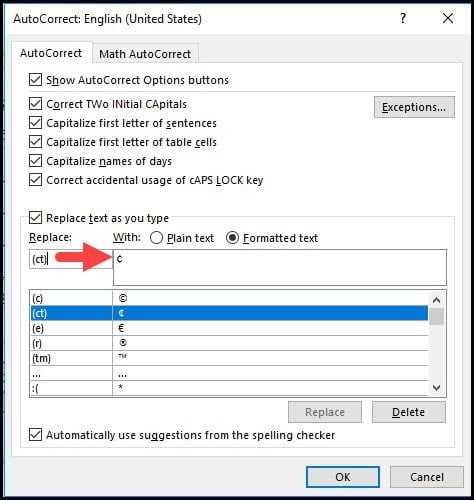
Windows Character Map
If you’re like me, you don’t like looking up codes. Instead, you want to see a graphical representation of the symbols and say “that one!” This is especially true if the symbol is one you rarely use. For these times, you can use Windows Character Map (charmap.exe).
To use Windows Character Map Tool,
- Press your Windows key + r. This should open Windows Run
- In the Open: textbox, type charmap.
An insert symbol tool similar to the one in Microsoft Word appears. When you click a symbol, a larger image appears with the description and key codes displayed on the status line. If this is a program you think you’ll use frequently, you might want to add it to your Windows taskbar.
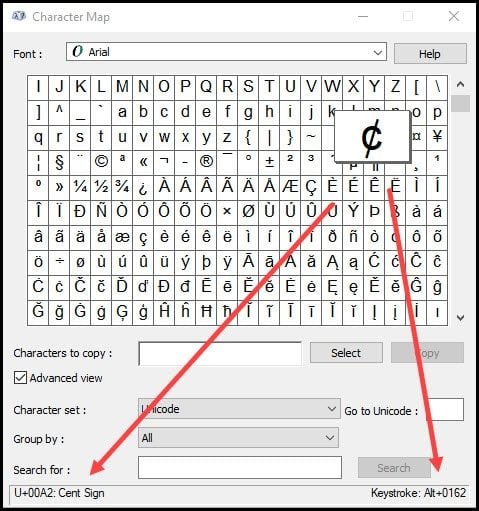
You can click the Select button and copy the symbol to your clipboard to paste it into another program. Or, you can type the keystroke equivalent.
Even though the character map is a system tool, it doesn’t mean the results will work everywhere you need them. The codes that seem to work without issue are Alt codes less than 255. And yes, it seems odd that ¼ works fine, but ⅛ produces a [.
And in case you’re wondering how I got that ⅛ symbol, it has to do with another set of codes that work with HTML. I suggest trying some of these examples and testing to see which ones work in your apps.
When You Don’t Know the Symbol Name
Sometimes, you’ve seen a symbol but are unsure of the name. These tend to be items used less often, such as the section sign, which looks like two overlapping S. In these circumstances, you can try to draw the symbol you need using Shape Catcher. Instead of searching by name, you draw the symbol you need in a specified box and click the Recognize link.

If I click the More Info link, I get details on how to enter the symbol.
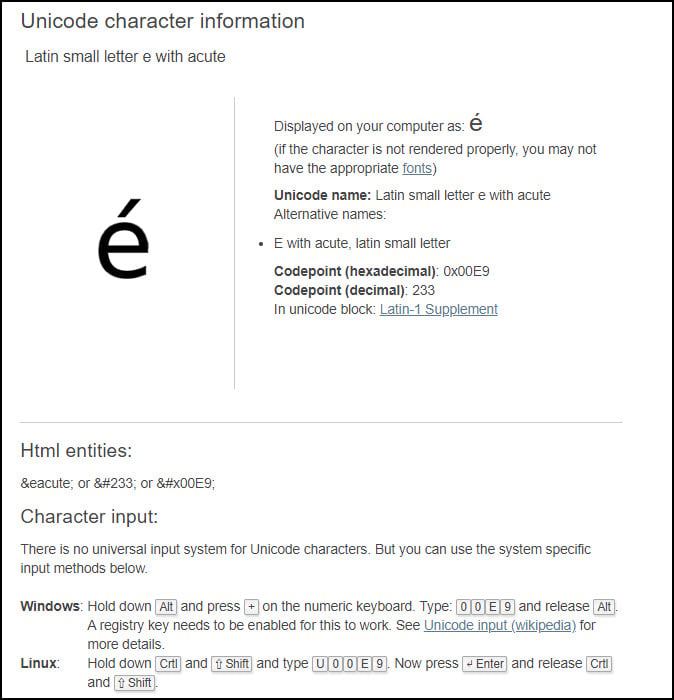
There are some other unknown symbols you might see along the way. One class is called replacement characters. Your application, such as Word or Excel, uses these characters when it can’t render an item.
How to Add Emojis
Last but not least are emojis. These are the symbols or ideograms you often see on social media sites. Think of smiley faces. With most of these applications, some built-in tool within the messaging app allows you to insert them easily. Emojis are also built into the Windows and Mac operating systems. Each OS has a keystroke combo to open the app.
Apple: Press Control + Command + space.
Using Windows Symbol App
While most people associate this tool with emojis, it does handle other symbols and Kaomojis. Kaomojis remind me of ASCII art but may incorporate Japanese characters. Sometimes you need to look at these a bit before getting the meaning.
| Name | Kaomoji |
| Annoyed | (¬_¬ ) |
| Shrugging | ¯\_(ツ)_/¯ |
To access the symbol tool,
- Press your Windows key
 and then ..
and then .. - The tool will pop up with Emojis highlighted.
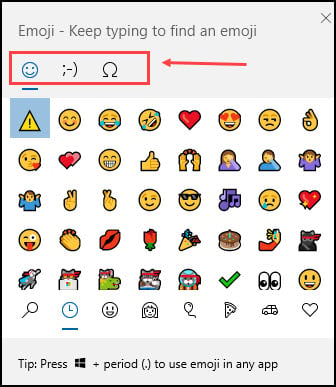
- Choose your symbol type from the top three icons.
- If you’re using Emojis, you can also start typing a name such as “heart”.
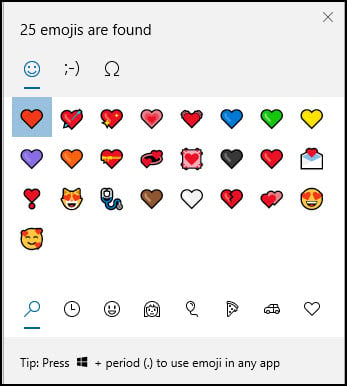
- Click the emoji you wish to use.
The process is similar to Kaomoji and symbols, except you need to do a visual search.
By now, you should know what are special characters and how to make symbols with your keyboard. No doubt, some people will commit their favorite ones to memory. Others may choose to use programs like ActiveWords to do text substitution. So remember you have many options the next time someone asks, “Do you know how to type this symbol?”.
